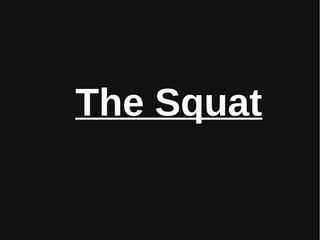
Squat presentation
- 1. The Squat
- 2. About me: ● REPs Level 3 personal trainer ● BSc (Hons) Strength + conditioning, sports- rehabilitation and massage ● SMA Accredited Sports massage practitioner My main interests: ● physical performance enhancement ● strength development
- 3. Overview: ● Definition ● Purpose + benefits ● Myths and misconceptions ● Factors affecting squat performance + solutions ● How squatting can help me ● Definitin
- 4. Definition: ● To crouch of sit with one's knees bent and one's heels close to touching one's buttocks of back of the thighs. ● (Oxford dictionary) The squat:
- 6. Purpose: ● To develop pushing strength and power in the quadriceps, hips and the back ● Benefits: ● Greater mobility and strength ● Improved bone density ● Improved running speed (Athletic) ● Improved physical performance (Charles Poliquin, 2014)
- 8. Full depth squatting is bad for the knees: ● Power lifters who squat >2xBW to 130 degrees of knee flexion have more stable knees than lifters who don't squat at all ● Squatting deeper places less stress on the knee ligaments ● Squatting deeper increases Glute activation ● If a baby can do it, so should we!!
- 9. Squats are bad for the back: ● Incorrect technique can lead to injury, just like any exercise!!!! ● Keep the neutral spine ● Chest lifted ● Strengthen your Glutes!!!!
- 10. Knees should never go past the toes: ● Lack of ankle flexibility, heels up ● Unbalanced distribution, a hinge movement ● Can increase risk of knee injury ● Knee travels over the toe in virtually all knee flexion exercises. (Climbing stairs, sitting down, standing up, running)
- 11. Squatting will slow me down: ● Studies have shown that squatting improves physical performance ● Squatting improves vertical lower body force development ● Higher force production= greater propulsion ● However squatting heavy by itself will not make you faster, appropriate speed specific training must also be applied
- 14. Ankle mobility: ● Inability to Dorsiflex the foot can lead to over compensation of the hips + knees ● Poor movement Patterns ● Inabilty to maintain neutral spine ● Knee injury!!! Causes: ● Previous injury ● Poor footwear (high heels) ● Poor posture (tight hips, Hunched shoulders) ● Tight Soleus muscles
- 15. Solution: ● Stretching of the Soleus muscles ● Squat with heels on step and progressively reduce the height of step ● Forefoot bounding ● Practising dorsiflexsion of the ankle
- 16. Hip mobility: ● Inability to maintain a neutral spine ● Lower back injury
- 17. Causes: ● Poor Posture -Too much sitting down (Gorilla posture) ● Muscle imbalance (Quad dominance) ● Poor ankle mobility
- 18. Solution: ● Stretching of the hip flexor muscles ● Improve ankle mobility ● Improve external hip rotation mobility ● Strengthening of the posterior chain ● Improve Core strength ● Improve upper back mobility
- 19. Weak Glutes: ● Inability to keep knees in line with the big toe ● Inability to maintain an upright torso throughout (Bum up technique) ● Increased risk of ACL injury
- 20. Causes: ● Poor recruitment patterns ● Deactivation (too much sitting down) ● Natural weakness in Glute Medius (Females) Solution: ● Improve hip extension (Glute bridges, kick- throughs, hip thrusts) ● Improve ability to resist internal rotation of the knee (Monster walks, step ups, lunges)
- 21. How can squatting help me?: ● Correct movement patterns can lead to improved efficiency and performance ● Improved mobility and strength in the lower body as well as the core stabilisers and upper back ● Increase in growth hormone production and therefore increase muscular development and strength all over the body ● Injury prevention
Hinweis der Redaktion
- <number>
- <number>
- <number>
- <number>
- <number>
- <number>
- <number>
- <number>
- <number>
- <number>
- <number>
- <number>
- <number>
- <number>
- <number>
- <number>
- <number>
- <number>
